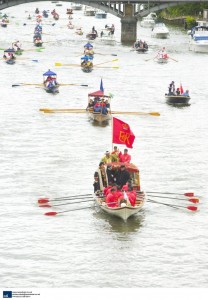
Queen Anne Boleyn’s coronation was a four day affair, beginning on the 29th May and culminating in the coronation ceremony on the 1st June, Whitsun.
The pageantry began at 1pm on Thursday 29th May when the London livery companies’ fifty barges set off from Billingsgate. These sixty to seventy foot long barges, escorted by small boats, were decorated with banners displaying the arms of the companies, streamers, bunting and cloth of gold. Minstrels entertained the fleet with music and in front of the Mayor’s barge was a “foyst”, or wherry, bearing a great dragon which was was “continually moving and casting wildfire”. This dragon was surrounded by “terrible monsters” and “wild men” also casting fire and making “hideous noises”. What a spectacle!
(You can get some idea of how the Thames looked that day by this photo of the river pageant organised by Historic Royal Palaces in 2009 for the 500th anniversary of Henry VIII’s accession.)
Then came the Mayor’s barge and the bachelors’ barge, which was full of musicians playing trumpet and other instruments. The bachelors’ barge was hung with cloth of gold and silk, and bore two huge banners displaying the arms of the King and Queen, along with streamers and bells. It also bore the arms of the company of “Haberdashers” and “merchant adventurers”, and on the starboard gunwale were thirty-six “scochyons”, or metal shields, showing the King and Queen’s arms impaled (the King’s colours on the right and the Queen’s colours on the left). These shields were fastened to hangings of cloth of gold and silver.
Another feature of this river procession was a wherry carrying Anne’s falcon badge. This crowned, white falcon stood on a gold tree stump surrounded by white and red roses, and “virgins singing and playing sweetly”.
The procession arrived at Greenwich Palace at 3pm to pick up the pregnant Queen and take her to the Tower of London. Anne appeared, dressed in cloth of gold, and boarded her barge. Anne’s ladies boarded a second barge and the King’s guard boarded the King’s barge – the King was not part of the procession. These three barges were joined by the barges of bishops and of courtiers. Noblemen in attendance that day included the Duke of Suffolk, the Marquess of Dorset, the Earls of Arundel, Derby, Rutland, Worcester, Huntingdon, Sussex and Oxford, and Anne’s father, Thomas Boleyn, Earl of Wiltshire. By this time there were “some 120 large craft and 200 small ones” on the Thames.
Letters and Papers describes how gun salutes heralded the Queen as she made her way along the Thames and that “when she came over against Wapping mills the Tower ‘lousyd their ordinaunce’ most triumphantly, shooting four guns at once.” Anne landed at Tower Wharf and was greeted by dignitaries lined up across the King’s bridge to the Tower’s private royal entrance, the Court Gate of the Byward Tower. Among the dignitaries were Sir Edward Walsingham, Lieutenant of the Tower, and Sir William Kingston, Constable of the Tower. When Anne entered the Tower, she was received by her husband, the King, “who laid his hands on both her sides, kissing her with great reverence and a joyful countenance”, before leading her to her chamber. The King and Queen then supped together.
Notes and Sources
- “The noble tryumphaunt coronacyon of Quene Anne, wyfe unto the most noble kynge Henry VIII”, printed by Wynkyn de Worde in 1533. This can be read online at http://archive.org/stream/maneroftryumpheo00goldiala#page/18/mode/2up
- Hall’s Chronicle, Edward Hall, p798-800
- LP vi. 563
- The Life and Death of Anne Boleyn, Eric Ives, p172-174